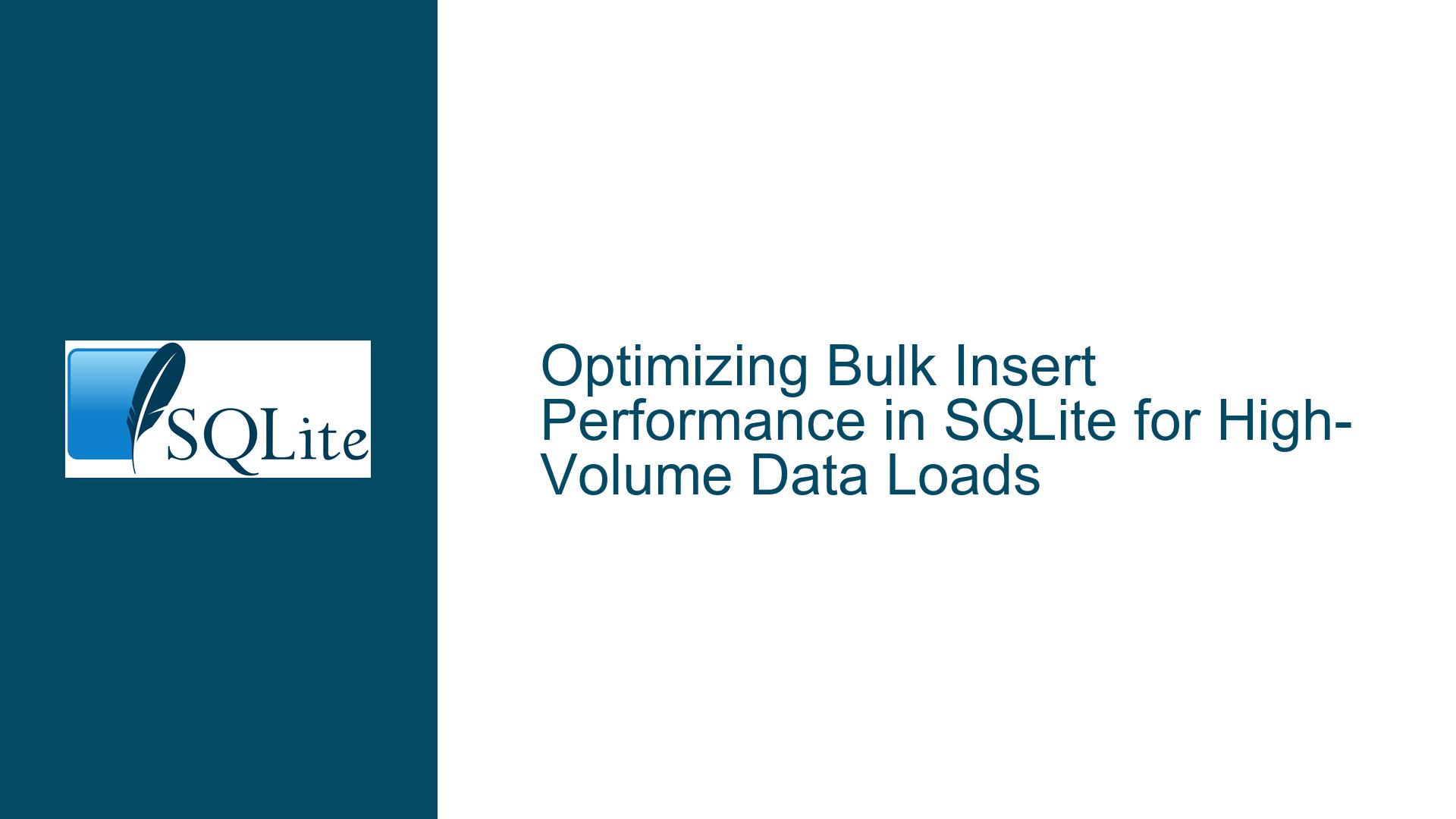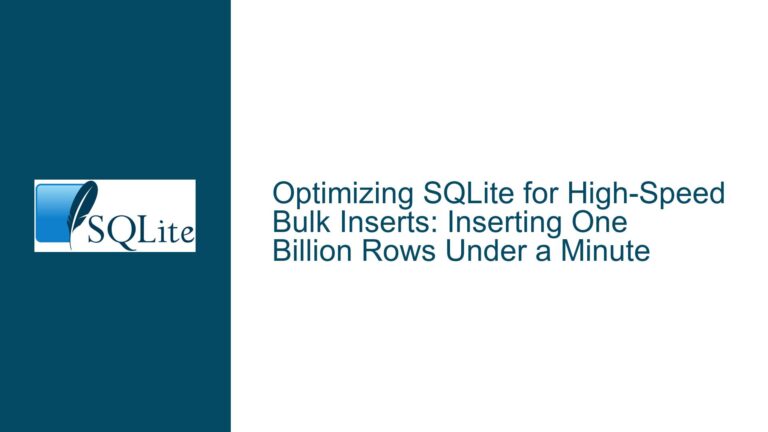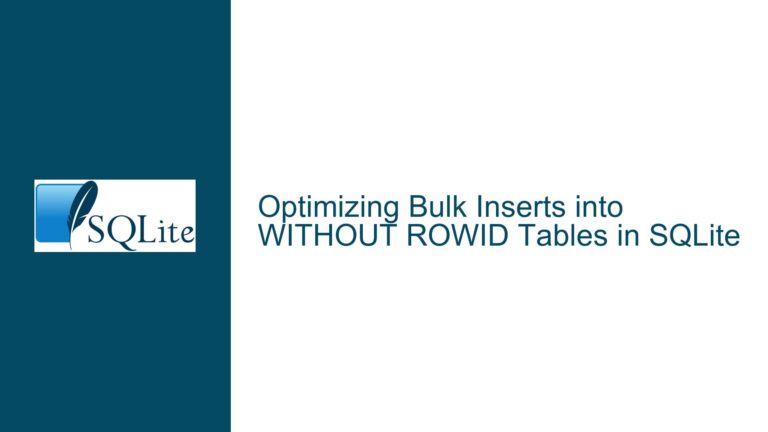Optimizing Bulk Insert Performance in SQLite for High-Volume Data Loads
Understanding Performance Bottlenecks in SQLite Bulk Insert Operations
The challenge of efficiently inserting tens of thousands of records into an SQLite database stems from the interplay of transactional semantics, hardware limitations, and schema design choices. SQLite’s default configuration prioritizes data integrity and durability over raw insertion speed, which becomes a critical limitation when handling bulk operations. Each standalone INSERT statement triggers an implicit transaction commit, forcing the database engine to synchronize changes with disk storage repeatedly. For 30,000 inserts, this results in 30,000 disk I/O operations under default settings—a process inherently constrained by physical storage latency.
Three primary factors exacerbate this bottleneck:
- Transaction Overhead: Without explicit transaction boundaries, SQLite uses autocommit mode, treating every insert as an atomic operation requiring full journal synchronization.
- Index Maintenance: Tables with indexes force the database to update index structures after each insert, multiplying write operations.
- Storage Media Characteristics: Rotational hard drives (as opposed to SSDs) magnify latency due to seek times, while network-attached storage introduces additional protocol overhead.
The cumulative effect of these factors creates quadratic time complexity for bulk inserts. A naively implemented loop of 30,000 inserts could require over 100,000 disk accesses when accounting for index updates, journal writes, and page cache flushes. This explains why initial implementations often yield abysmal performance metrics—15 minutes or more for modest datasets.
Critical Factors Impacting Insert Throughput in SQLite
Transaction Management Deficiencies
Autocommit mode remains the most severe performance killer. Each INSERT triggers:
- A journal file update (unless using
MEMORYorOFFjournal modes) - A filesystem sync operation (if
PRAGMA synchronous=FULL) - Page cache flushing to disk
These operations dominate execution time. For example, a mechanical hard drive with 5ms average seek time would spend 150 seconds (30,000 × 5ms) just on head positioning for journal writes alone.
Suboptimal PRAGMA Configuration
Default PRAGMA settings prioritize crash safety over speed:
journal_mode=DELETEforces separate journal file creation with fsync().synchronous=FULLguarantees data persistence after every commit.cache_size=-2000allocates only ~2MB of page cache.locking_mode=NORMALallows concurrent readers during writes.
While these are prudent for transactional systems, they become prohibitive for bulk loads where temporary data loss might be acceptable.
Index Update Overhead
Every inserted row requires updates to all associated indexes. A table with three indexes effectively quadruples write operations (1 heap write + 3 index writes). Worse, B-tree rebalancing during index updates can fragment pages, requiring additional I/O for overflow management.
Prepared Statement Misuse
Repeatedly preparing and discarding insert statements incurs parsing and optimization costs. Parameter binding reuse is critical—SQLite can cache execution plans for prepared statements, avoiding redundant parsing.
Strategic Approaches for Accelerating Mass Inserts in SQLite
Transaction Batching: The Foundation of Performance
Wrap all inserts within a single explicit transaction:
BEGIN IMMEDIATE;
-- 30,000 INSERT statements
COMMIT;
This collapses 30,000 disk sync operations into one. The IMMEDIATE transaction type acquires a reserved lock immediately, preventing concurrent writers from triggering SQLITE_BUSY errors.
Implementation Considerations:
- Use
BEGIN IMMEDIATEinstead ofBEGINto avoid deadlocks in multi-threaded environments. - For extremely large datasets (1M+ rows), commit every 50,000-100,000 rows to prevent memory bloat from rollback journal accumulation.
- Ensure proper error handling with
ROLLBACKon failure.
PRAGMA Tuning for Controlled Risk
Adjust durability guarantees to match operational requirements:
PRAGMA journal_mode=MEMORY; -- Store rollback journal in RAM (crash unsafe)
PRAGMA synchronous=OFF; -- No fsync() calls (risk corruption on power loss)
PRAGMA locking_mode=EXCLUSIVE; -- Hold write lock for entire process
PRAGMA cache_size=-1000000; -- 1GB page cache
PRAGMA temp_store=MEMORY; -- Keep temp objects in RAM
Trade-off Analysis:
journal_mode=MEMORYvsOFF: MEMORY keeps journal in process memory, allowing rollback within the transaction. OFF eliminates journaling entirely—faster but unable to recover from crashes.synchronous=OFFcan yield 10x speed improvements but risks entire database corruption if the OS crashes mid-write.cache_sizeshould be sized to the working set. For 30k inserts, calculate:(Row size + Index overhead) × Rows × Safety factor = (100 bytes × 30,000) × 2 = ~6MBOver-provisioning to 1GB keeps all dirty pages in memory, minimizing disk flushes.
Index Deferral Strategy
For tables with indexes:
- Drop indexes before bulk insert:
DROP INDEX idx_column1; DROP INDEX idx_column2; - Perform inserts.
- Recreate indexes:
CREATE INDEX idx_column1 ON table1(column1); CREATE INDEX idx_column2 ON table1(column2);
Performance Characteristics:
- Index maintenance during inserts has O(n log n) complexity. Rebuilding indexes post-insert is O(n) with sort.
- Test with
EXPLAIN QUERY PLANto verify index usage patterns. - For databases with existing data, consider
REINDEXafter bulk operations.
Bulk Insert Query Optimization
Parameter Binding
Use prepared statements with bound parameters:
sqlite3_stmt *stmt;
sqlite3_prepare_v2(db, "INSERT INTO t1 VALUES (?, ?)", -1, &stmt, NULL);
for (int i=0; i<30000; i++) {
sqlite3_bind_text(stmt, 1, data[i].col1, -1, SQLITE_TRANSIENT);
sqlite3_bind_text(stmt, 2, data[i].col2, -1, SQLITE_TRANSIENT);
sqlite3_step(stmt);
sqlite3_reset(stmt);
}
sqlite3_finalize(stmt);
This avoids SQL parsing overhead and allows SQLite to reuse execution plans.
Batch Insert Syntax
Leverage UNION ALL for small batches:
INSERT INTO t1 (col1, col2)
SELECT 'val1' AS col1, 'val2' AS col2 UNION ALL
SELECT 'val3', 'val4' UNION ALL
...
However, this approach has diminishing returns beyond 500 rows per statement due to memory constraints.
Alternative Storage Configurations
In-Memory Databases
For ephemeral data:
sqlite3_open(":memory:", &db);
Combine with ATTACH DATABASE for hybrid persistence:
ATTACH DATABASE 'physical.db' AS disk;
-- Create tables in memory
INSERT INTO disk.table1 SELECT * FROM memory.table1;
Write-Ahead Logging (WAL) Mode
For concurrent read/write access:
PRAGMA journal_mode=WAL;
WAL allows readers to coexist with a single writer, but bulk inserts may still benefit from exclusive locking.
Filesystem and OS-Level Tuning
- RAM Disks: Store the database on a tmpfs or RAM disk for purely in-memory operation.
- Disable File System Journaling: On Linux, use
data=writebackmount option for ext4. - I/O Scheduler: Use deadline/noop schedulers for SSDs.
Monitoring and Validation
Verify configuration effectiveness:
SELECT * FROM pragma_journal_mode;
SELECT * FROM pragma_synchronous;
Use .timer on in sqlite3 CLI to measure execution times.
Expected Performance Metrics:
| Configuration | 30k Inserts Time |
|---|---|
| Defaults | 15+ minutes |
| Transaction + PRAGMA | 10-30 seconds |
| RAM Disk + All Optimizations | <5 seconds |
Disaster Recovery Considerations
When using synchronous=OFF or journal_mode=OFF:
- Regularly back up the database during long operations.
- Use checksums to detect corruption:
PRAGMA integrity_check; - Consider periodic commits (every 10k rows) to minimize data loss scope.
This comprehensive approach balances raw insert speed with recoverability, adapting SQLite’s durability guarantees to match operational requirements. For non-critical bulk data loads, the 1000x performance improvement justifies temporary relaxation of ACID constraints.






